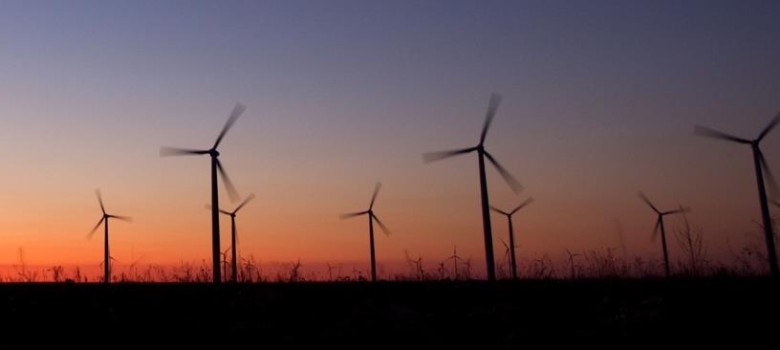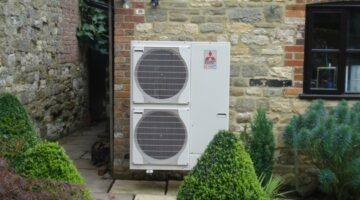
Wind turbines on a commercial scale
For wind turbine basics and an explanation on how they work, please visit the Wind Turbines section. The major difference between residential and commercial is the scale. While a wind turbine on your house may produce some or all of your electricity needs, a wind farm (a collection of commercial wind turbines) can provide electricity for many thousands of houses.
While most residential wind turbines tend to be less than 50kW, the largest commercial turbines found on wind farms are now in excess of 6MW. The largest turbine to date, the Enercon E-126 has a hub height of 135m, and a rotor diameter of 126m. It was originally designed to produce 6MW of electricity, but the capacity has been upped to 7.5MW. This one wind turbine can provide enough electricity for approximately 5000 households.
Maximising the power produced by a wind farm
There are numerous features that commercial wind turbines use to maximise the amount of power they produce.
Firstly the pitch of the rotors is automatically altered to catch the most wind. The yaw angle is a misalignment between the direction of the wind and the turbine pointing direction, therefore the turbine is actively controlled by an automated wind vane to minimise this angle – again maximising the power of wind.
Many old style wind turbines rotate at the same speed regardless of the wind strength due to a gearing system within the generator, however new turbines including the E-126 are gearless, with the blades rotating at whatever speed generates the most electricity. Gearless generators are more efficient, as energy is not lost via the gearing system.
The towers tend to be at higher altitudes as at altitude the surface aerodynamic drag is lower, so wind speeds are higher and more constant.
Finally the blades are made from glass-fibre reinforced polyester or wood-epoxy, so they are lighter than old style turbines, and they can therefore accelerate quicker to adapt to wind strength.
What is a wind farm?
Onshore vs. offshore wind power
A wind farm is a collection of commercial size wind turbines located either inland (onshore) or out at sea (offshore). Onshore wind has a much bigger presence in the UK at the moment, just because the technology to support it has been around for much longer than offshore wind. Therefore onshore wind at the moment provides a much higher percentage of the total energy mix than offshore wind in the UK.
In the UK, both onshore and offshore wind farms are subsidised through the Renewables Obligation Certificates (ROCs), with onshore wind farms supported by 1 ROC and offshore wind farms by 2 ROCs. As the UK is a member of the EU, subsidising industry goes against the spirit of the Single Market, however the exceptions exist in the renewable energy generation sectors.
This is because to get to a level playing field for wind power with the current fossil fuel technologies, European governments need to give these renewable industries a helping hand to encourage investment. As has been seen elsewhere in the industry, in the medium term, where investment has been followed by innovation, the price of these technologies has fallen. As a result in the UK, the governments have reduced ROC support gradually as this technology has become more price competitive.
The level of support for offshore wind farms needs to be greater as the technology is more expensive and there is quite a way for it to go before it reaches competitiveness vs. the fossil fuel technologies. Bloomberg New Energy Finance (BNEF), however calculates that the output cost of electricity by onshore wind from 2016, will reach parity with fossil fuels. This is to be driven by further efficiencies and developments in the technology.
Onshore and offshore wind in Europe
In Europe, the largest wind farm currently in production is the £4.5bn Markbygden Wind Farm based in Northern Sweden. This project will be finished by 2020 and will comprise of 1,101 turbines, made up of the E-126 turbines and Enercon E-101 (3MW outage), covering 450km2. The total energy output of the farm will be 12 terawatt hrs/year (TWh), which will be equivalent to the domestic consumption of 2 million houses per year.
As well as building wind farms on land, many offshore projects are being built around the continent. Europe is the leader in offshore wind energy, with the first farm being built in Denmark in 1991. As of 2010 there were 39 offshore wind farms located in waters across Europe. Like in the UK, the opinion is that offshore windfarms are now preferred over onshore windfarms because they are less obtrusive than those built on land, and their noise and size is mitigated by their location away from urban areas.
In addition, water has less surface roughness than land, so the average wind speed is higher out at sea so, thereby increasing the electricity generating capacity of these farms. However, there are environmental impacts to consider for offshore wind turbines – their construction can destroy fishing habitats, and there is a large amount of oil needed to lubricate efficient operation of turbines which has the potential to leak and affect the marine ecosystem.
Wind power development
Wind power is intermittent, only producing electricity when the wind blows and the blades are spinning, so without storage, wind power cannot be aligned to the demand fluctuations very easily. Many larger power stations also lack flexibility in their production of electricity, for example, a nuclear or coal power station produces the same amount of electricity every minute, and this electricity cannot be stored.
Throughout the day there is differing demand for electricity, so during night the demand is lower than at dinner time for example. Therefore, within the electricity mix there needs to be a variety of sources to deal with this fluctuation in demand and one of the most flexible is hydroelectric. This can be turned on and off within seconds to meet any extra demand. Tethering of wind turbines to hydroelectric facilities is currently being investigated; by using the wind power to pump the water back to the top reservoir, the whole system requires no external power support so is completely green and is therefore a very flexible electricity production method.
UK commercial wind power policy
In the UK, there is a largely confusing message projected concerning the future of wind power. While many scientists, investors and environmentalist groups are unequivocal in their support, others have voiced their opposition, particularly on the subject of onshore wind. Although onshore technology is now developed and building windfarms is relatively cheap, environmentalists have objected to more being built as they further blight an already disappearing countryside. Those that support onshore wind have criticised successive governments for reducing, and signalling further reductions in the ROC support.
Offshore wind has been hailed as ‘the future’ for renewable power and a technology where UK engineering can really excel, and export that expertise for the benefit of growing a low carbon economy. Bodies like the Energy Intensive User Group, on the other hand, object to the level ROC support for offshore wind (currently 2 ROCs as mentioned above), and call for a solution that is based on economics and cost – such as increased efficiency measures, increased nuclear and increased onshore wind.
Despite the confusing messages, investment and implementation of onshore and offshore wind continues in the UK and in particular Scotland. For example, in early 2012, SSE, announced that it had surpassed 1GW of energy generation from its onshore wind farms. Further investment is being planned by companies such as Infinergy, Vattenfall and Gamesa in both of these two technology areas. Offshore however is going to require more technological advancement before it sees accelerated growth and energy cost parity with other technologies.
In Europe, the trend has continued to accelerate commercial wind development. There is much ongoing research into wind turbines and the aim is to increase their capacity and output. Denmark is leading the way with ambitious target setting – planning to deliver half of its renewable energy output with wind power. Other big projects include: (1) Norwegian company Sway is currently building a 10MW turbine that is due for completion this year (although it will undergo two years of testing); (2) Plans afoot to build a 15MW turbine off the coast of Spain by 2015, called the Azimut.
Read our thoughts on the future of wind power here.












No Comments yet! Be the first one.